
 |
Tea Clipper |
 |
| from TeaAntiques.com | ||
| Edition Ninety Six |
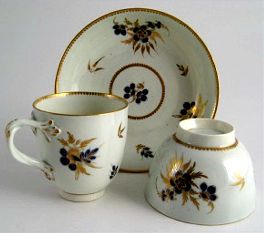 A
very attractive Worcester trio, comprising tea bowl, coffee cup and saucer, c1785.
The coffee cup has extremely elegant double 'entwined' handles and all three pieces
are exquisitely decorated with underglaze blue and finely gilded formal flowers.
A
very attractive Worcester trio, comprising tea bowl, coffee cup and saucer, c1785.
The coffee cup has extremely elegant double 'entwined' handles and all three pieces
are exquisitely decorated with underglaze blue and finely gilded formal flowers.
The body of the pieces are each decorated with three main formal flower sprays with the flowers of underglaze cobalt blue which are then embellished with very finely applied gilt decoration. There are also minor sprigs in gilt and blue formally positioned about the pieces.
The rims are decorated with gilt 'dentils' and the saucer has a central circular cartouche created from further gilded 'dentils', in the centre of this circle is a further flower head in blue and gold.
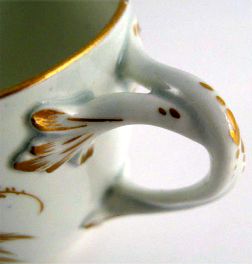
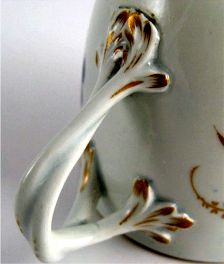
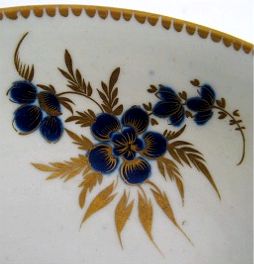
More details of this item and other tea related antiques can be found by visiting my web site at www.TeaAntiques.com.
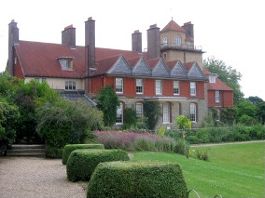 Unlike
many National Trust houses, Standen in West Sussex is not approached along a grand
drive, is not huge, grand or imposing. On the contrary, Standen is situated at the
end of a narrow lane and is unimposing, nestled into the hill side with views extending
out over Ashdown Forest. In comparison to many National Trust houses it is not that
old either, built in 1892-4 for James Beale, a wealthy London solicitor and his
large family. What makes Standen special, is that it was the creation of the now
famous William Morris and Philip Webb partnership.
Unlike
many National Trust houses, Standen in West Sussex is not approached along a grand
drive, is not huge, grand or imposing. On the contrary, Standen is situated at the
end of a narrow lane and is unimposing, nestled into the hill side with views extending
out over Ashdown Forest. In comparison to many National Trust houses it is not that
old either, built in 1892-4 for James Beale, a wealthy London solicitor and his
large family. What makes Standen special, is that it was the creation of the now
famous William Morris and Philip Webb partnership.
William Morris is synonymous with his unique designs for fabrics and wallpapers and Philip Webb for his style in architecture and furnishings. As a partnership, they were to lead the way in the latest fashion of 'Arts and Crafts'.
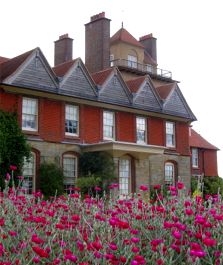 Philip
Webb designed and built with the upmost care and consideration. Such was his attention
to detail, that he didn't produced many buildings. His choice of materials for the
building of Standen were inspired by the original farm house which still remains
close by and is now linked to the house with an archway. The farm house is built
with local stone, bricks and red hung tiles, the exact same materials that Webb
was to incorporate into his newly designed house. Stone was quarried from the ground
very near to the site of the house, later the quarry was used for an interesting
'Quarry Garden' - a damp dell ideally suited to ferns and shade loving plants. Bricks
and the red hung tiles were sourced locally. He also used local oak for weather
boarding.
Philip
Webb designed and built with the upmost care and consideration. Such was his attention
to detail, that he didn't produced many buildings. His choice of materials for the
building of Standen were inspired by the original farm house which still remains
close by and is now linked to the house with an archway. The farm house is built
with local stone, bricks and red hung tiles, the exact same materials that Webb
was to incorporate into his newly designed house. Stone was quarried from the ground
very near to the site of the house, later the quarry was used for an interesting
'Quarry Garden' - a damp dell ideally suited to ferns and shade loving plants. Bricks
and the red hung tiles were sourced locally. He also used local oak for weather
boarding.Although the style of the 'Arts and Crafts' movement was revolutionary at the end of the nineteenth century, it took its style and influence from early periods. Webb's design of the house used earlier architectural elements such as 17th century pointed gables covered with weather boards, Georgian 12-pane sash windows, Tudor leaded light windows combined to create an informal, light filled house that would suit James Beale and his large family.
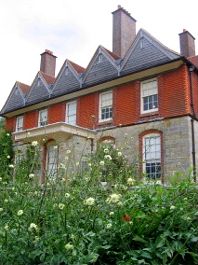 With
Webb designing the house, some of the furniture and fixings, and Morris providing
the fabrics and wallpapers, it would appear that between them they had the entire
project sewn up. This was not quite the case, as James Beale and his family were
to make a few architectural changes when they moved in. With a liking for the earlier
periods, they brought into the house furniture influenced by Eighteenth century
designers like Chippendale and Sheraton, whose designs were being revived and in
vogue. The house today, still contains much of the original content, fabrics and
fixings and is an important ensemble from the start of the 'Arts and Crafts' era.
With
Webb designing the house, some of the furniture and fixings, and Morris providing
the fabrics and wallpapers, it would appear that between them they had the entire
project sewn up. This was not quite the case, as James Beale and his family were
to make a few architectural changes when they moved in. With a liking for the earlier
periods, they brought into the house furniture influenced by Eighteenth century
designers like Chippendale and Sheraton, whose designs were being revived and in
vogue. The house today, still contains much of the original content, fabrics and
fixings and is an important ensemble from the start of the 'Arts and Crafts' era.
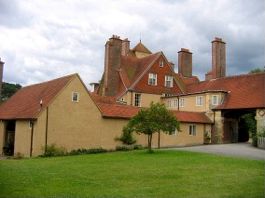 We
enter the house today through an archway that links the original 'great Hollybush'
farmhouse to the new house courtyard. To the left is part of the kitchen wing and
in front of us the North elevation of the house. Even now, the full extent of the
revolutionary house design is not visible and is not so until the house is viewed
from the garden on the East and South sides. The North elevation is quite plain
and simple, even somewhat haphazard. There appears to be no overall design theme
or consistency. There are parts built in stone, some areas of brick, windows of
the Georgian sash style alongside large leaded light windows. It does however work
and the Kitchen wing is linked to the North elevation of the house with a tall square
water tower and belvedere. This tower is coated with painted stucco.
We
enter the house today through an archway that links the original 'great Hollybush'
farmhouse to the new house courtyard. To the left is part of the kitchen wing and
in front of us the North elevation of the house. Even now, the full extent of the
revolutionary house design is not visible and is not so until the house is viewed
from the garden on the East and South sides. The North elevation is quite plain
and simple, even somewhat haphazard. There appears to be no overall design theme
or consistency. There are parts built in stone, some areas of brick, windows of
the Georgian sash style alongside large leaded light windows. It does however work
and the Kitchen wing is linked to the North elevation of the house with a tall square
water tower and belvedere. This tower is coated with painted stucco.
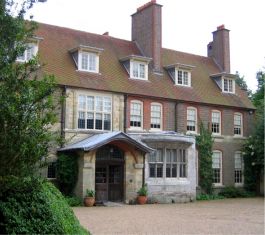 A
porch protruding from the North elevation provides the simple entrance into the
Hall. The Hall is not just an entrance, but a family room, with a piano, comfortable
armchairs and a handsome long case clock.
A
porch protruding from the North elevation provides the simple entrance into the
Hall. The Hall is not just an entrance, but a family room, with a piano, comfortable
armchairs and a handsome long case clock.
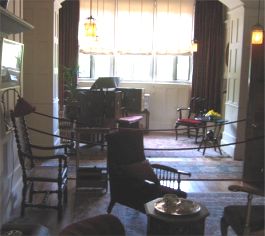 This
room was used by James Beale, his wife Margaret, their children and grandchildren
for singing and playing of music. When the Beale's moved into the house, the Hall
was a little smaller and the wood panelled walls painted a deep 'dragon's blood'
red. In 1898, they had Webb extend it by adding an alcove with bay at the far end
to accommodate the piano and to add more light. The panelling was also painted an
off-white. Webb's designs included all the chimneypieces in the house, all of which
are different.
This
room was used by James Beale, his wife Margaret, their children and grandchildren
for singing and playing of music. When the Beale's moved into the house, the Hall
was a little smaller and the wood panelled walls painted a deep 'dragon's blood'
red. In 1898, they had Webb extend it by adding an alcove with bay at the far end
to accommodate the piano and to add more light. The panelling was also painted an
off-white. Webb's designs included all the chimneypieces in the house, all of which
are different.
In the Hall, the chimneypiece is designed with a high arched shape with the mantle
supported in the centre with an extended key stone in the Baroque style. As well
as coal fires, the house was fitted with central heating to supplement the heating.
From the outset, Standen was lit by electric lights, initially powered by a donkey
engine in the old barn. Many of the light
fittings were designed by W.A.S Benson, a protégé of Morris.
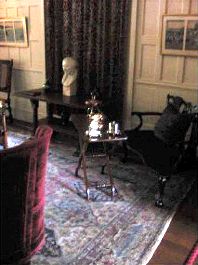 The
textiles in the Hall were provided by William Morris, including the 'Vine' design
wallpaper 1873 and the printed valveteen hangings of his 'Wey' pattern, c1883.
The
textiles in the Hall were provided by William Morris, including the 'Vine' design
wallpaper 1873 and the printed valveteen hangings of his 'Wey' pattern, c1883.
To the right of the Hall is the Billiard Room dominated by the billiard table and was a room to which the men would retire after breakfast for a smoke and later in the evening for a game of billiards. It was not only the men played billiards in the Beale family, their daughter Helen played and taught the game to any of her cousin's and nieces who could be relied upon not to tear the baize! As with the Hall there were a few changes made to this room after the Beale's had moved in. In 1898, Webb added an alcove which cut off part of the conservatory corridor behind and which gave space for a comfortable seating area and some display cabinets. The alcove was papered above the half height wood panelling with Morris's 'Pomegranate' paper. On the mantelpiece are some vases that include a pair of Doulton vases in a blue green colour and decorated with an 'Arts and Crafts' leave shaped pattern, c1920.
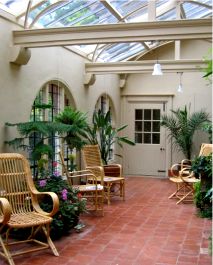 Passing
out of the Billiard Room, along the Conservatory Corridor leads to the Conservatory.
This is a delightful room which epitomises Webb's love for light and light interior.
It was an idyllic spot for the family to take afternoon tea on sunny afternoons.
The family were very keen on afternoon tea, as were many families in this period.
There were three types of afternoon tea - 'family tea' which was a tea for the family
members only and would consist of some bread and butter and some cakes; 'High Tea'
which was held on the same day and time each week and was by invitation only to
friends and other guests and would comprise a hot savoury dish as well as the cakes;
and a 'Household Tea' which was like the family tea, but open to close friends and
relatives.
Passing
out of the Billiard Room, along the Conservatory Corridor leads to the Conservatory.
This is a delightful room which epitomises Webb's love for light and light interior.
It was an idyllic spot for the family to take afternoon tea on sunny afternoons.
The family were very keen on afternoon tea, as were many families in this period.
There were three types of afternoon tea - 'family tea' which was a tea for the family
members only and would consist of some bread and butter and some cakes; 'High Tea'
which was held on the same day and time each week and was by invitation only to
friends and other guests and would comprise a hot savoury dish as well as the cakes;
and a 'Household Tea' which was like the family tea, but open to close friends and
relatives.
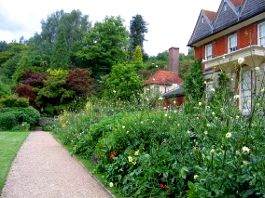 To
the far end of the Conservatory, is a doorway into the Drawing Room, one of three
principle rooms on the ground floor. From this room there are fine views of the
garden and the Medway valley beyond. As this room would be used mainly in the afternoon,
Webb designed it with windows only on the East and South facing sides so the family
would not be bothered by direct sunlight. It is a lovely light room with off-white
painted wood panelling and panels of Morris's 'Sunflower' wallpaper designed in
1879. The sunflower was a popular emblem and can be seen incorporated in the Webb
designed copper wall light fittings and the cheeks of the fireplace. Furniture in
this room includes many comfortable arm chairs, covered in Morris's fabrics, small
occasional tables and china display cabinets. Some of the furniture, although contemporary
with the 'Arts and Crafts' period, hark back in their design to Chippendale and
Sheraton etc and include a 'Chippendale' double back settee. One painting caught
my eye, that of 'Tea in the Garden' by Dame Ethel Walker. This charming, rather
impressionistic painting, shows a lady sitting in the garden taking tea from an
elegantly laden tea tray, and her children at play close by in the garden.
To
the far end of the Conservatory, is a doorway into the Drawing Room, one of three
principle rooms on the ground floor. From this room there are fine views of the
garden and the Medway valley beyond. As this room would be used mainly in the afternoon,
Webb designed it with windows only on the East and South facing sides so the family
would not be bothered by direct sunlight. It is a lovely light room with off-white
painted wood panelling and panels of Morris's 'Sunflower' wallpaper designed in
1879. The sunflower was a popular emblem and can be seen incorporated in the Webb
designed copper wall light fittings and the cheeks of the fireplace. Furniture in
this room includes many comfortable arm chairs, covered in Morris's fabrics, small
occasional tables and china display cabinets. Some of the furniture, although contemporary
with the 'Arts and Crafts' period, hark back in their design to Chippendale and
Sheraton etc and include a 'Chippendale' double back settee. One painting caught
my eye, that of 'Tea in the Garden' by Dame Ethel Walker. This charming, rather
impressionistic painting, shows a lady sitting in the garden taking tea from an
elegantly laden tea tray, and her children at play close by in the garden.
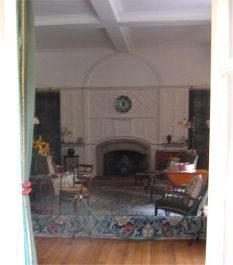
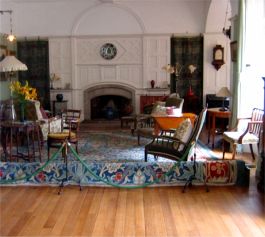
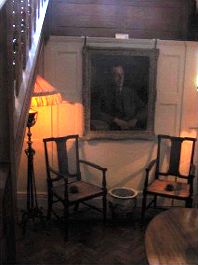
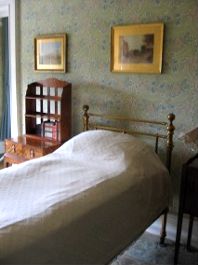 Leaving
the Drawing Room, leads us into the Staircase and Inner Hall. The staircase, designed
by Webb, is of wood and has flat pierced balustrades in the style of the 17th Century.
Under the stairs is a glass display cabinet in which is displayed a fine collection
of William De Morgan's ruby lustre decorated pottery. Moving up the stairs leads
to a set of bedrooms and Dressing Rooms, each with its own decoration using William
Morris's papers and fabrics. The rooms are furnished with Victorian brass beds,
each beautifully polished and shiny. In The Westbourne Bedroom, there is an inlaid
satinwood wardrobe and dressing table with an adjustable oval dressing mirror, designed
by Garrets in the 1870's. Many of the light fixings and table lamps were designed
by Benson. There are many items of 'Arts and Crafts' ceramics to be seen in these
rooms.
Leaving
the Drawing Room, leads us into the Staircase and Inner Hall. The staircase, designed
by Webb, is of wood and has flat pierced balustrades in the style of the 17th Century.
Under the stairs is a glass display cabinet in which is displayed a fine collection
of William De Morgan's ruby lustre decorated pottery. Moving up the stairs leads
to a set of bedrooms and Dressing Rooms, each with its own decoration using William
Morris's papers and fabrics. The rooms are furnished with Victorian brass beds,
each beautifully polished and shiny. In The Westbourne Bedroom, there is an inlaid
satinwood wardrobe and dressing table with an adjustable oval dressing mirror, designed
by Garrets in the 1870's. Many of the light fixings and table lamps were designed
by Benson. There are many items of 'Arts and Crafts' ceramics to be seen in these
rooms.
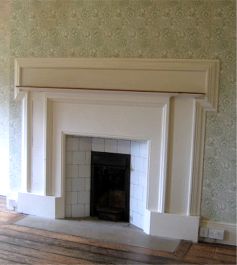
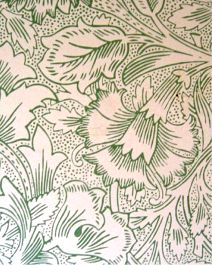
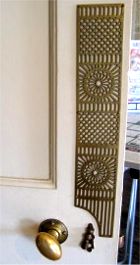
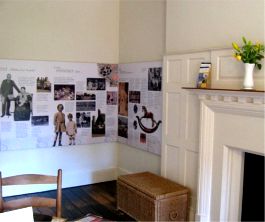
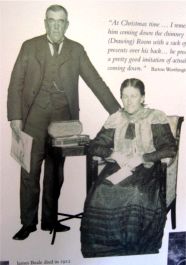 One
bedroom is now devoted to an exhibition room, with information about the history
of the house and the Beale family, etc. It also has a cabinet with a set of sliding
drawers in which are sections of William Morris's named designs for wallpapers.
Many of these papers are still reproduced and are popular today.
One
bedroom is now devoted to an exhibition room, with information about the history
of the house and the Beale family, etc. It also has a cabinet with a set of sliding
drawers in which are sections of William Morris's named designs for wallpapers.
Many of these papers are still reproduced and are popular today.
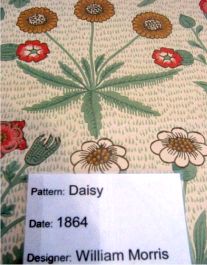
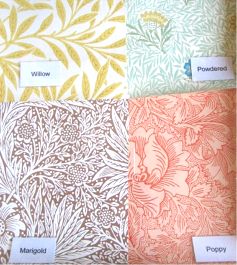
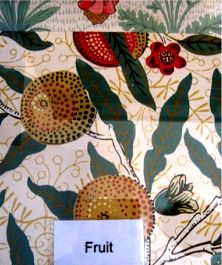
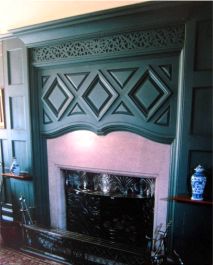 Returning
downstairs, the next room is the Dining Room. Here the wood panelled walls are painted
a soft dark green against which is displayed blue and white Chinese porcelain. This
combination was much favoured by Webb and Morris. Much of the furniture in the room
is of an earlier style, from the early eighteenth century. There is a circular dining
table with pad feet and dining chairs with solid shaped wooden back splats, cabriole
legs with pad feet and turned stretchers. There are two fitted dressers, designed
by Webb. On a sideboard stands a very stylish tea kettle on stand and a silver plated
on copper 'hot-plate' with two covered dishes. There is a pierced silver cake basket
of eighteenth century style, inscribed and given to the Beales as a wedding present
in 1870.
Returning
downstairs, the next room is the Dining Room. Here the wood panelled walls are painted
a soft dark green against which is displayed blue and white Chinese porcelain. This
combination was much favoured by Webb and Morris. Much of the furniture in the room
is of an earlier style, from the early eighteenth century. There is a circular dining
table with pad feet and dining chairs with solid shaped wooden back splats, cabriole
legs with pad feet and turned stretchers. There are two fitted dressers, designed
by Webb. On a sideboard stands a very stylish tea kettle on stand and a silver plated
on copper 'hot-plate' with two covered dishes. There is a pierced silver cake basket
of eighteenth century style, inscribed and given to the Beales as a wedding present
in 1870.
From the Dining Room, a Morning Room Corridor leads to the Morning Room, so named as it was used in the morning and at that time of day, would catch the morning sunshine. It was a room used mainly by the ladies of the house, maybe to do some embroidery, chat, read the papers and write letters. Some of the walls and windows are hung with a 'Daffodil' chintz, designed by Dearle, c1891. There are Morris designed reclining armchairs, these covered in Morris's 'Snakeshead' chintz. There is a collection of ceramics by Dela Robbia, including a majolica charger and vase in tones of yellow ochre, brown and green.
Near to the Morning Room is the Business Room. This room is adjacent to the kitchen block and servant quarters, so James Beale could keep an eye on the movement of servants and deal with the domestic business of running the house. His desk and cabinets are made of walnut, the desk the work of Henry Davoll in 1921.
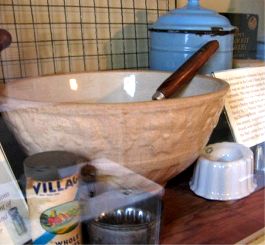 The
servants' wing of the house was designed and built with the same care and attention
to detail as the house itself. The Butler's Pantry was strategically placed to afford
a view of the servants' corridor and also the front courtyard for arriving visitors.
Next to the Butler's pantry, the Servants' Hall is placed where it will catch the
evening light, the time when the servants would maybe have a little time to relax.
In the early life of the house the domestic staff would have included 9 or 10 indoor
maids, cook-housekeeper and the butler. One of the store rooms now contains a small
exhibition of the servant's life and the things of which would have been familiar
to them, such as a hand whisk, sugar cutters, butter pats and icing piping kits
etc. There was in one cupboard a blue packet of Henry Headley's 'Elephant tea'.
The
servants' wing of the house was designed and built with the same care and attention
to detail as the house itself. The Butler's Pantry was strategically placed to afford
a view of the servants' corridor and also the front courtyard for arriving visitors.
Next to the Butler's pantry, the Servants' Hall is placed where it will catch the
evening light, the time when the servants would maybe have a little time to relax.
In the early life of the house the domestic staff would have included 9 or 10 indoor
maids, cook-housekeeper and the butler. One of the store rooms now contains a small
exhibition of the servant's life and the things of which would have been familiar
to them, such as a hand whisk, sugar cutters, butter pats and icing piping kits
etc. There was in one cupboard a blue packet of Henry Headley's 'Elephant tea'.
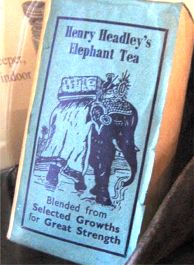
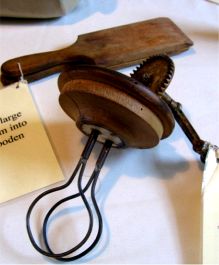
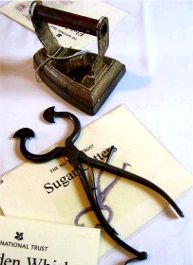
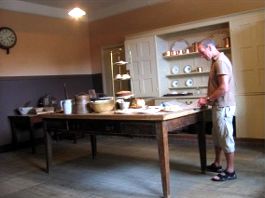 The
Kitchen, was redecorated in 2001/2 to a colour scheme that had been kept by the
Beale family until to the 1960's. The walls are painted in drab brown for the lower
half with light cream above. The cast-iron range was supplied by Smith and Wellstood
Ltd., London and is the original. In the centre of the room stands a long table
which was supplied from Maple's store. This is very interesting, laid out with the
delights ready for an afternoon tea, with sponge and fruit cakes, biscuits and iced
fancy cakes. The recipes for these came from a book called 'Wholesome food' written
by James Beales sister-in-law, Marie Thompson. The book was written under a pseudonym,
as it may not have been thought a respectable thing to have done by their class.
The recipes for cakes would certainly have been made and served here at Standen,
enjoyed by the family and their guests.
The
Kitchen, was redecorated in 2001/2 to a colour scheme that had been kept by the
Beale family until to the 1960's. The walls are painted in drab brown for the lower
half with light cream above. The cast-iron range was supplied by Smith and Wellstood
Ltd., London and is the original. In the centre of the room stands a long table
which was supplied from Maple's store. This is very interesting, laid out with the
delights ready for an afternoon tea, with sponge and fruit cakes, biscuits and iced
fancy cakes. The recipes for these came from a book called 'Wholesome food' written
by James Beales sister-in-law, Marie Thompson. The book was written under a pseudonym,
as it may not have been thought a respectable thing to have done by their class.
The recipes for cakes would certainly have been made and served here at Standen,
enjoyed by the family and their guests.
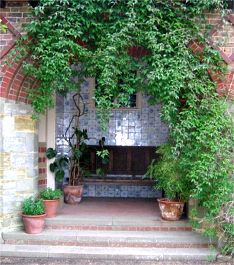
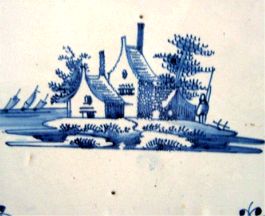 The
gardens of Standen extend above and down away from the house, with the house being
cut into the hill side and the stone quarry behind it. Walking round the east and
south sides of the house, there is at the end of the Conservatory a small recessed
Summer House. This was used by the young children when it was wet in which to play.
It is said that, Helen the youngest of the Beales children, then aged 7, asked Webb
to build them a special 'Little Room' for her, for which he charged her sixpence.
This charming little retreat is lined with Delft blue and white tiles, some with
beautiful little scenes of houses, windmills and people as well as animals, like
a wild bear.
The
gardens of Standen extend above and down away from the house, with the house being
cut into the hill side and the stone quarry behind it. Walking round the east and
south sides of the house, there is at the end of the Conservatory a small recessed
Summer House. This was used by the young children when it was wet in which to play.
It is said that, Helen the youngest of the Beales children, then aged 7, asked Webb
to build them a special 'Little Room' for her, for which he charged her sixpence.
This charming little retreat is lined with Delft blue and white tiles, some with
beautiful little scenes of houses, windmills and people as well as animals, like
a wild bear.
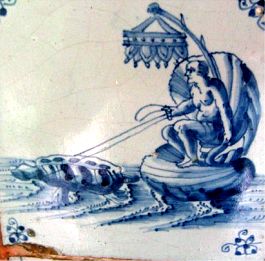
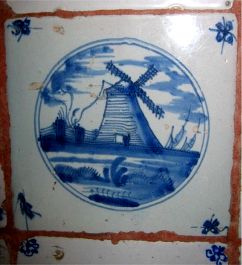
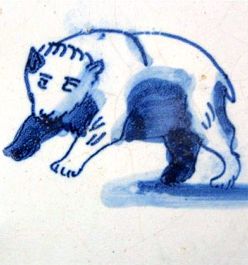
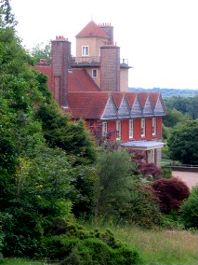
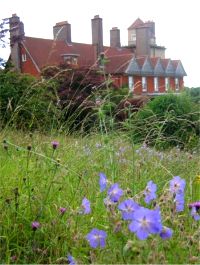
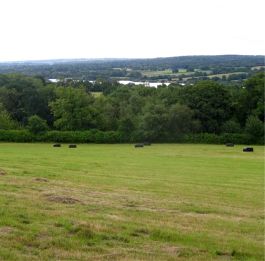
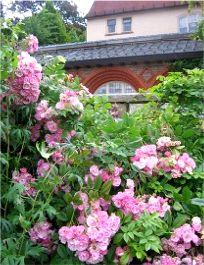
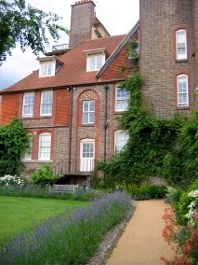 Wandering
down the hill there are the Bamboo garden, Rhododendron Dell, Croquet Lawn and Kitchen
Garden to be enjoyed. It is worth looking back from time to time to take advantage
of different views of the house. In the Kitchen garden are some very old espalier
fruit trees, these from the initial garden planted and still thriving. This garden
provided the Beale's with fresh fruit and vegetables for Standen and their other
London houses. Now, it still has a variety of fruit and vegetables and some flower
grown for cutting for the house or for sale.
Wandering
down the hill there are the Bamboo garden, Rhododendron Dell, Croquet Lawn and Kitchen
Garden to be enjoyed. It is worth looking back from time to time to take advantage
of different views of the house. In the Kitchen garden are some very old espalier
fruit trees, these from the initial garden planted and still thriving. This garden
provided the Beale's with fresh fruit and vegetables for Standen and their other
London houses. Now, it still has a variety of fruit and vegetables and some flower
grown for cutting for the house or for sale.
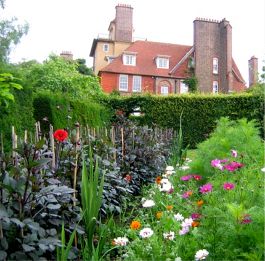
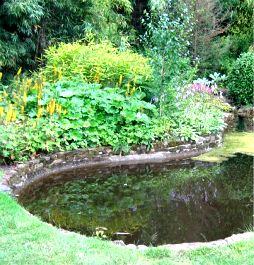
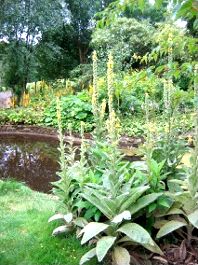
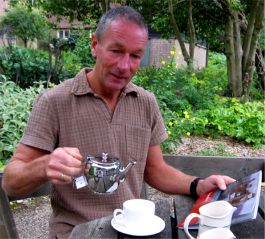 After
your visit, you may wish to refresh yourself with some tea and refreshments in the
Old Barn restaurant and tearoom. For my visit, I was content
with just a pot of Earl Grey tea.
After
your visit, you may wish to refresh yourself with some tea and refreshments in the
Old Barn restaurant and tearoom. For my visit, I was content
with just a pot of Earl Grey tea.
Standen, is an important house in that it was the brainchild and creation of the Philip Webb and William Morris partnership at the beginning of the 'Arts and Crafts' movement in Britain. A worthwhile house and garden to visit if ever you get the opportunity.
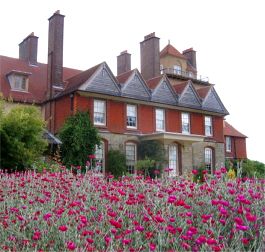 Standen
StandenTo review past newsletters, just follow this link:
Past newsletters.
To subscribe to this free newsletter -
Click here